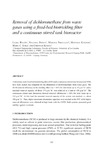Removal of dichloromethane from waste gases using a fixed-bed biotrickling filter and a continuous stirred tank bioreactor

View/
Use this link to cite
http://hdl.handle.net/2183/12847Collections
Metadata
Show full item recordTitle
Removal of dichloromethane from waste gases using a fixed-bed biotrickling filter and a continuous stirred tank bioreactorAuthor(s)
Date
2007Citation
Biotechniques for Air Pollution Control II, 2007: 505-514. ISBN: 978-84-9749-258-4
Abstract
[Abstract] A laboratory scale fixed bed biotrickling filter (BTF) and a continuous stirred tank bioreactor (CSTB) have been studied and compared for the elimination of dichloromethane from waste gases. The DCM removal efficiency in the trickling filter was > 85% for inlet loads up to 25 g.m-3.h-1 and a maximal removal capacity of about 170 g.m-3.h-1 was achieved at a load of 350 g.m-3.h-1. The continuous stirred tank bioreactor showed removal efficiencies > 90% for inlet loads up to 120 g.m-3.h-1. At this load the maximal removal capacity of the system was reached, i.e. about 100 g.m-3.h-1. Thus, higher maximum elimination capacities were reached in the BTF while higher removal efficiencies were obtained at high loads with the CSTB. Both systems presented good stability against overloads.
ISBN
978-84-9749-258-4





